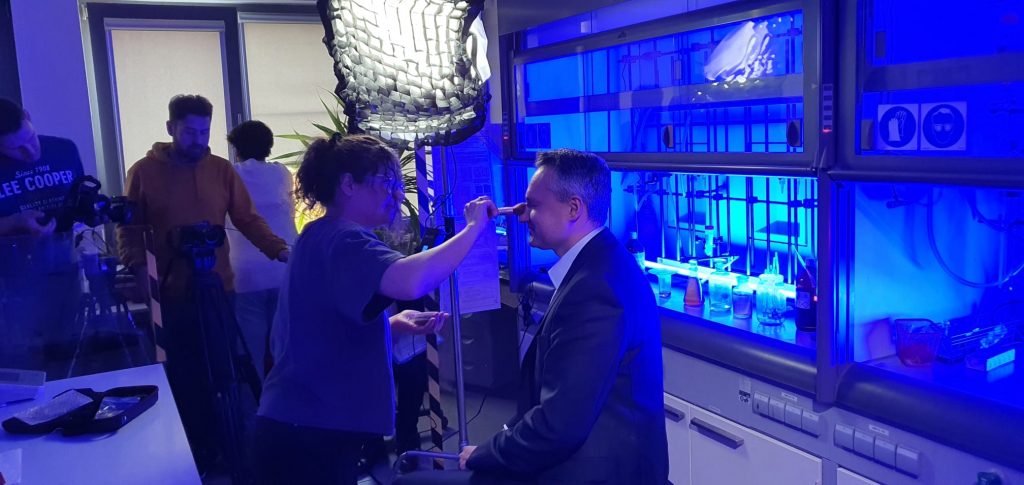Tandem rigidification and π-extension as a key tool for the development of a narrow linewidth yellow hyperfluorescent OLED system
by Krzysztof Bartkowski, Paola Zimmermann Crocomo, Michał Andrzej Kochman, Dharmandra Kumar, Adam Kubas, Przemysław Data, Marcin Lindner
Hyperfluorescence (HF), a relatively new phenomenon utilizing the transfer of excitons between two luminophores, requires careful pairwise tuning of molecular energy levels and is proposed to be the crucial step towards the development of new, highly effective OLED systems. To date, barely few HF yellow emitters with desired narrowband emission but moderate external quantum efficiency (EQE < 20%) have been reported. This is because a systematic strategy embracing both Förster resonance energy transfer (FRET) and triplet to singlet (TTS) transition as complementary mechanisms for effective exciton transfer has not yet been proposed. Herein, we present a rational approach, which allows, through subtle structural modification, a pair of compounds built from the same donor and acceptor subunits, but with varied communication between these ambipolar fragments, to be obtained. The TADF-active dopant is based on a naphthalimide scaffold linked to the nitrogen of a carbazole moiety, which through the introduction of an additional bond leads not only to π-cloud enlargement, but also rigidifies and inhibits the rotation of the donor. This structural change prevents TADF, and guides bandgaps and excited state energies to simultaneously pursue FRET and TTS processes. New OLED devices utilizing the presented emitters show excellent external quantum efficiency (up to 27%) and a narrow full width at half maximum (40 nm), which is a consequence of very good alignment of energy levels. The presented design principles prove that only a minor structural modification is needed to obtain commercially applicable dyes for HF OLED devices.
Understanding structure–properties relationships of porphyrin linked to graphene oxide through π–π-stacking or covalent amide bonds
Anna Lewandowska-Andralojc, Ewelina Gacka, Tomasz Pedzinski, Gotard Burdzinski, Aleksandra Lindner, Jessica M O’Brien, Mathias O Senge, Aleksandra Siklitskaya, Adam Kubas, Bronislaw Marciniak, Justyna Walkowiak-Kulikowska
Two graphene oxide nanoassemblies using 5-(4-(aminophenyl)-10,15,20-triphenylporphyrin (TPPNH2) were fabricated by two synthetic methods: covalent (GO-CONHTPP) and noncovalent bonding. GO-CONHTPP was achieved through amide formation at the periphery of GO sheets and the hybrid material was fully characterized by FTIR, XPS, Raman spectroscopy, and SEM. Spectroscopic measurements together with theoretical calculations demonstrated that assembling TPPNH2 on the GO surface in DMF-H2O (1:2, v/v) via non-covalent interactions causes changes in the absorption spectra of porphyrin, as well as efficient quenching of its emission. Interestingly, covalent binding to GO does not affect notably neither the porphyrin absorption nor its fluorescence. Theoretical calculations indicates that close proximity and π–π-stacking of the porphyrin molecule with the GO sheet is possible only for the non-covalent functionalization. Femtosecond pump–probe experiments revealed that only the non-covalent assembly of TPPNH2 and GO enhances the efficiency of the photoinduced electron transfer from porphyrin to GO. In contrast to the non-covalent hybrid, the covalent GO-CONHTPP material can generate singlet oxygen with quantum yields efficiency (ΦΔ = 0.20) comparable to that of free TPPNH2 (ΦΔ = 0.26), indicating the possible use of covalent hybrid materials in photodynamic/photothermal therapy. The spectroscopic studies combined with detailed quantum-chemical analysis provide invaluable information that can guide the fabrication of hybrid materials with desired properties for specific applications.




